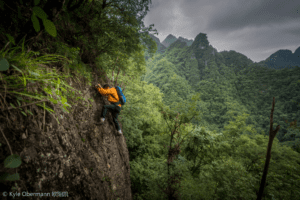One night near the city of Wuhan, Xia and I boarded a river barge plying the Yangtze on a three-day journey to Chongqing.
Dazzling 2,000-foot cliffs appeared in the morning, soaring above us and seemed to go for hundreds of miles. According to our maps, we were in the first of China’s great three rivers’ gorges, and the base of an enormous and botanically rich mountain range known as Shenggonjia- the home to the god of edible and medicinal plants. This range was revered for rugged scenery, mythical ape-like hominids called Yeren, and biodiversity of temperate plants as rich as any botanical garden.

These high crags protected the largest primary forest remaining in China. Golden Monkeys, Cloud Leopards, and Giant Salamanders which can reach 5 feet in length and weigh 100 pounds are found here.
This region also marks the transition from subtropical to cool temperate climes with an explosion of cold-tolerant endemic plants. Relatives of modern-day citrus fruit, such as Ichandarins and Poncirus grow naturally and can withstand temperatures well below zero.
Considering the stunning cold peaks and the sweet fragrance that poured down from them, it would be sacrilegious as a plant lover to pass up a chance to botanize our way into the forest and meet the inhabitants who had foraged these highlands for millennia. I told Xia we should prepare to jump ship when the opportunity presented. He was stunned, then he couldn’t stop smiling.

Taking a chance at the town of Zigui- an ancient brick and stone village situated on a steep shelf with a churning white-water tributary running through it, (and now 300 feet below water since the dam was made near Wuhan) we hoisted our packs and bounced down the gangplank to a rocky shoreline. There, the locals were clambering amongst themselves, hawking medicinal plants, endemic vegetables, and animal skins destined for richer markets in the cities up and downriver. Some villagers gawked in amazement as we hurried onto the first road, which as it turned out, was the only access the residents had to link the Yangtse and their mountain abodes. Or maps had indicated a paucity of roads or townships in the range of Shennogjia. This was one of them. I hid by pressing close to Xia’s side and we keep moving as fast as we could. We got through the first village check post before we could attract attention from any officials.
“Cold Mountain Road’s a joke, no cart track, no horse trail.
Creeks like veins, but still it’s hard to mark the twists.
Fields and fields of crags for crops, it’s hard to say how many.
Tears of dew upon a thousand kinds of grasses; the wind sings best in one kind of pine.
And now I’ve lost my way again: Body asking shadow, “Which way from here?”Han Shan Tang Dynasty (618-907)
Leave a Reply